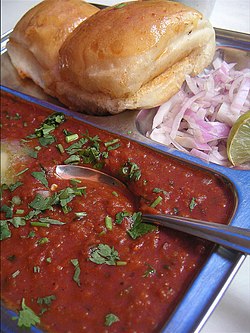Pav bhaji
Pav bhaji is a fast food dish from India consisting of a thick vegetable curry (bhaji) served with a soft bread roll (pav). Its origins are in the state of Maharashtra.[1]
 | |
| Alternative names | Bhaji-pav |
|---|---|
| Course | Meal |
| Place of origin | |
| Region or state | Maharashtra |
| Main ingredients | Bread, mixed vegetables |
HistoryEdit
The dish originated as a fast lunchtime dish for textile mill workers in Mumbai.[2][3] Pav bhaji was later served at restaurants throughout the city.[3][4] Pav bhaji is now offered at outlets from simple hand carts to formal restaurants in India and abroad.[5][6]
PreparationEdit
Pav bhaji being prepared on an iron tava
A pav bhaji stand at Chandni Chowk, Delhi
Pav bhaji is a spiced mixture of mashed vegetables in a thick gravy served with bread. Vegetables in the curry may commonly include potatoes, onions, carrots, chillies, peas, bell peppers and tomatoes. Street sellers usually cook the curry on a flat griddle (tava) and serve the dish hot. A soft white bread roll is the usual accompaniment to the curry, but this does not preclude the use of other bread varieties such as chapati, roti or brown bread.
VariantsEdit
Variations on pav bhaji include:
- Cheese pav bhaji, with cheese on top of the bhaji
- Fried pav bhaji, with the pav tossed in the bhaji
- Paneer pav bhaji, with paneer cheese in the bhaji
- Mushroom pav bhaji, with mushrooms in the bhaji
- Khada pav bhaji, with vegetable chunks in the bhaji
- Jain pav bhaji, without onions and garlic[7] and with plantains instead of potatoes[8]
- Kolhapuri pav bhaji, using a spice mix common in Kolhapur
- White pav bhaji, with no garam masala and no chilli powder
ReferencesEdit
- ↑ Najmi, Quaid. "Meet Mumbai's rags-to-riches Restaurant King". The New indian Express. Retrieved 31 May 2015.
- ↑ Patrao, Michael. "Taking pride in our very own pav". Deccan Herald. The Printers (Mysore) Private Ltd. Retrieved 31 May 2015.
- ↑ 3.0 3.1 Patel, Aakar. "What Mumbaikars owe to the American Civil War: 'pav bhaji'". Live Mint. HT Media Limited. Retrieved 31 May 2015.
- ↑ Munshaw-Ghildiyal, Rushina. "A feast of flavours". Hindustan Times. HT Media Limited. Archived from the original on 20 April 2015. Retrieved 31 May 2015.
- ↑ Pathak, Anil. "'Bhaji pav' to invade NY's Times Square". The Times of India. Bennett, Coleman & Co. Ltd. Retrieved 13 January 2015.
- ↑ Rajesh, Monisha. "10 of the best street foods in Mumbai". The Guardian. Guardian News and Media Limited. Retrieved 2 September 2015.
- ↑ Dalal, Tarla (2010). Mumbai's Roadside Snacks. Mumbai: Sanjay & Company. p. 60. ISBN 978-81-89491-66-6. Retrieved 31 May 2015.
- ↑ Kumar, Shikha. "In search of the perfect pav bhaji". Hindustan Times. HT Media Limited. Retrieved 4 March 2017.